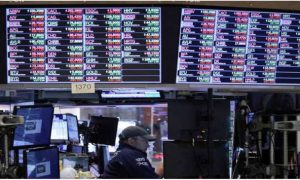The stock market has been hitting one record high after another. It’s tempting to declare that the market is pricing in a Donald Trump win over Kamala Harris, which—at first glance—would be viewed as a more Wall Street-friendly outcome. But correlation is not causation.

This recent rally in stocks likely has a lot more to do with the Federal Reserve’s willingness to keep cutting interest rates and the fact that corporate earnings are pretty healthy and are expected to improve in 2025, rather than what the election polls are saying. The job market remains resilient as well.
A look at some of the leaders in the stock market’s latest surge tells us that the Dow Jones Industrial Average and S&P 500’s recent strength is likely due to a still stable economy and improving corporate fundamentals. After all, the big gainers aren’t just the Magnificent Seven of tech. It’s financials, industrials, and consumer discretionary stocks—sectors that do well when the economy is steadily growing. American Express, Goldman Sachs, Caterpillar, GE Aerospace, Ralph Lauren, and Booking Holdings have all been on hot streaks.
Also Read- Are Stock Markets Open on Monday for Columbus Day?
“Cyclical-oriented stocks, which are sensitive to economic shifts, continue to exhibit bullish market breadth profiles, indicating that investors are confident in economic growth prospects,” said Dean Christians, senior research analyst with SentimenTrader, in a report Tuesday.
Christians noted that more than 15% of the S&P 500’s consumer discretionary, financial, and industrial stocks hit a 52-week high on Friday. That is only the 31st time this has happened since 1954, and it’s usually a healthy sign for future returns, he says. The average gain for the S&P 500 over the next 12 months in those instances was 13.4%.
The stock surge continued Monday before cooling off Tuesday. Christians pointed out in another report Tuesday that more than 30% of the stocks in the financial and industrial sectors hit 52-week highs on Monday. That has occurred just 21 times in the past 70 years.
Bespoke Investment Group also noted the rally of financials and industrials, as well as tech. The Bespoke analysts argued that financials and industrials stocks in particular could pull back in the short-term, due to how well they have done lately. But they added that many stocks in these two sectors have been hitting new 52-week highs, offering a healthy sign for the longer term. Momentum is clearly on their side.
In other words. lower interest rates, waning inflationary pressures, and a still healthy labor market bode well for cyclical stocks. That may include real estate as well.
“Stick with rotation/cyclicals trades in financials and real estate, given the favorable rate relief environment…as well as recent China growth measures and the potential for pro-growth policies from either prevailing presidential candidate,” said the investment strategy team at iCapital in a report this month.
Even though the Consumer Discretionary Select Sector, Financial Select Sector SPDR, and Industrial Select Sector SPDR exchange-traded funds are now trading at or near their 52-week highs, that doesn’t mean that stocks in these sectors can’t climb even further.
Lamar Villere, portfolio manager with Villere & Co., told Barron’s that his firm owns shares of megabank JPMorgan Chase, casino owner Caesars Entertainment, sneaker upstart On Holding, and recent initial public offering Lineage, a leader in cold storage warehouses. He says all four should benefit from an economy that seems to be on the path to a soft landing.
The iCapital strategists added that the presidential race should create opportunities to buy more cyclical stocks in the coming weeks. There likely will be some notable swings in the market between now and November 5.
“While the upcoming election may be a source of volatility, it’s worth remembering that this volatility tends to peak before the election and subsides afterward, regardless of the outcome,” the iCapital strategists wrote.
Also Read– This elegant solution to expanding the grid costs half as much as building new power lines
The bottom line? Don’t fight the trend. Focus more on the Fed, macroeconomic data and earnings—and less on Trump, Harris, and the battle for control of Congress—when trying to manage your portfolio.



































